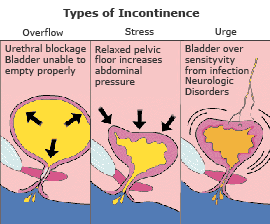Urinary Dysfunction / Urinary incontinence Treatment in India
Urinary incontinence (UI) is the loss of urine control, or the inability to hold your urine until you can reach a restroom. More than 12 million people in the United states of America experience incontinence - male and female (women over age 50 are the most likely to develop UI), young and old. Urinary incontinence may be a temporary condition, resulting from an underlying medical condition. It can range from the discomfort of slight losses of urine to severe, frequent wetting.

Causes
Incontinence is not an inevitable result of aging, but is particularly common in older people. It is often caused by specific changes in body function that may result from diseases, use of medications, and/or the onset of an illness. Sometimes, it is the first and only symptom of a urinary tract infection.
Types
The following are some of the different types of urinary incontinence:
- Urge incontinence; the inability to hold urine long enough to reach a restroom. It is often found in people who have conditions such as diabetes, stroke, dementia, Parkinson's disease, and multiple sclerosis, but may be an indication of other diseases or conditions that would also warrant medical attention.
- Stress incontinence; the most common type of incontinence that involves the leakage of urine during exercise, coughing, sneezing, laughing, lifting heavy objects, or other body movements that put pressure on the bladder.
- Functional incontinence; leakage due to a difficulty reaching a restroom in time because of physical conditions such as arthritis.
- Overflow incontinence; leakage that occurs when the quantity of urine produced exceeds the bladder's capacity to hold it.
Symptoms
The following are the most common symptoms of urinary incontinence. However, each individual may experience symptoms differently. Symptoms may include:
- inability to urinate
- pain related to filling the bladder and/or pain related to urination without a proven bladder infection
- progressive weakness of the urinary stream with or without a feeling of incomplete bladder emptying
- an increased rate of urination without a proven bladder infection
- needing to rush to the restroom and/or losing urine if you do not get to restroom in time
- abnormal urination or changes in urination related to a nervous system
- abnormality such as stroke, spinal cord injury, multiple sclerosis
- leakage of urine that prevents activities
- leakage of urine that began or continued after surgery
- leakage of urine that causes embarrassment
- frequent bladder infections
The symptoms of urinary incontinence may resemble other conditions or medical problems. Always consult your physician for a diagnosis.
Diagnosis
For people with urinary incontinence, it is important to consult a physician for a complete physical examination that focuses on the urinary and nervous systems, reproductive organs, and urine samples. In many cases, patients will then be referred to a urologist, a physician who specializes in diseases of the urinary tract.
Treatments
Specific treatment for urinary incontinence will be determined by your physician based on:
- your age, overall health, and medical history
- extent of the disease
- your tolerance for specific medications, procedures, or therapies
- expectations for the course of the disease
- your opinion or preference
Treatment may include:
- certain behavioral techniques (including pelvic muscle exercises, biofeedback, and bladder training)
- medications
- surgery (if the incontinence is related to structural problems such as an abnormally positioned bladder or a blockage)
- diet modifications (including eliminating caffeine in coffee, soda, and tea, and/or eliminating alcohol)
Management
There are many products and devices available for managing urinary incontinence. Specifically designed absorbent underclothing is available - which is no more bulky than normal underwear and can be worn easily under everyday clothing. Other incontinence products include washable, adult cloth diapers or contoured cloth diapers with plastic covers.
In some cases, depending upon the type of incontinence and after other management methods have proven to be ineffective, a catheter may be inserted into the urethra to collect the urine. Catheters may be used occasionally or on a constant basis, in which case a tube connects to a bag that attaches to the leg. Men can use a type of external catheter, condom catheter device that is placed over the penis and connects to a bag that attaches to the leg.
| Copyright © 2024 www.edtreatmentindia.com All Rights Reserved. |










